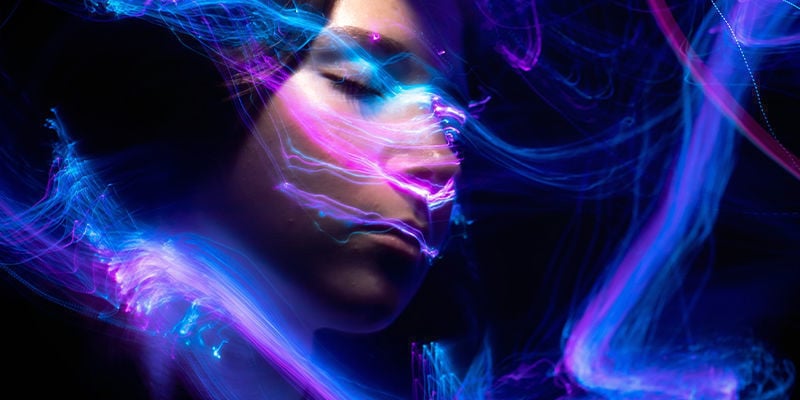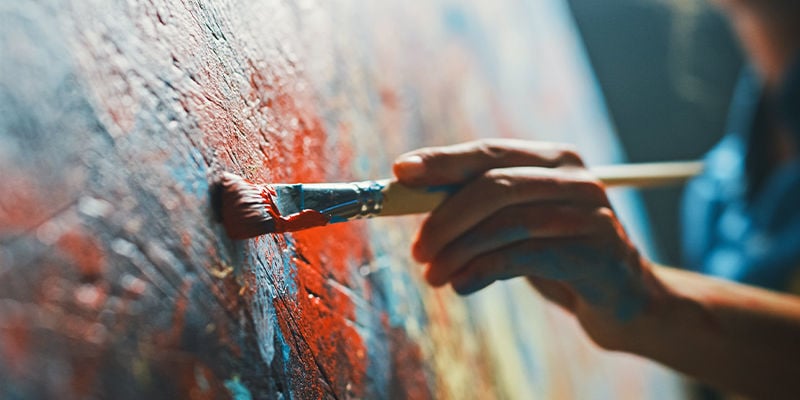
Drawing On Acid: How Hallucinogens Inspire Creativity
During the late 1950s and early 1960s, psychedelics, particularly acid and shrooms, surged in popularity when they became more widely available. Since then, a lot of research has centred around the idea that hallucinogens influence the inner workings of our brain and facilitate creativity.
So is it true? Do hallucinogens lead to an altered state of mind where creativity flows freely like water through an uninhibited river?
Studies show that acid can do wonders to improve cognitive performance, lower inhibitions and lead to enhanced feelings of self-actualisation, all of which contribute to the very essence of creating art.
RESEARCH ON HALLUCINOGENS AND CREATIVITY

During a 1960s study led by James Fadiman and Willis Harman at San Francisco State College, more than two dozen artists were observed after ingesting hallucinogens. All twenty-seven subjects were given LSD or peyote and prompted to complete a creative thinking, problem-solving workshop. The following represent quotes from participants recounting how hallucinogens affected them:
“There was no fear, no worry, no sense of reputation…,” “…a lowered sense of personal danger…” and “…the normal blocks in the way of progress seemed absent…”
THE BIGGER PICTURE

Each participant reported heightened functioning including refined creativity and the ability to observe problems from a different perspective. Under the influence of LSD, it was easier for artists to look at “the bigger picture.”
One participant determined, “I could handle two or three different ideas at the same time and keep track of each” while another said that “Looking at the same problem with psychedelic materials, I was able to consider it in a much more basic way, because I could form and keep in mind a much broader picture.”
An improved sense of coherence was also noted among the artists. “I began to work feverishly, to keep up with the flow of ideas.”
Hallucinogens by definition intensify fantasies, visual imagery, auditory senses and they lead to profound connections with external stimuli. One participant examined “…my senses could not keep up with my images” and “I was very impressed with the ease with which ideas appeared…it was the pure fun of doing, inventing, creating, and playing.”
Under the influence of psychedelics, the subconscious becomes your active state of mind, making your imagination tangible.
A psychedelic trip can be lucid, substantial and downright inspiring. As stated in the study, "The subjects were able to move imaginary parts in relation to each other, enabling fantasies to trigger ideas in order to find solutions to their problems." And according to one man, “It would have taken a great deal of effort and racking of the brains to arrive at what seemed to come more easily during the session.”
DO HALLUCINOGENS BREED CREATIVITY?

So, arriving back at the original question... do hallucinogens make people more creative? Not exactly. Creativity is first and foremost found within the artist. Furthermore, technical artistic proficiency requires hours upon hours of dedicated practice.
However, psychedelic experiences can foster creativity that is already there, allowing an individual to uncover the full scope of their abilities. Luckily, creativity doesn't dissipate when the high is gone. After completing the experiment, study participants stated that creative influences lasted for months and even years after the psychedelic experience. Similar to the way travelling exposes individuals to unique cultures and ideas, hallucinogens allow people to connect with new concepts and ideas in the venue of abstract reality.
LEVELS OF TRIPPING

A 1968 study by Masters and Houston organised the different levels of an acid trip into four distinct categories: sensory, recollective-analytic, symbolic and integral.
The sensory level begins with enhancements in basic vision, touch and hearing, which eventually evolves into what is known as synesthesia or "cross-sensing." An example of this phenomenon is when you “hear” colours and “taste” sounds. Next is the recollective-analytic stage, where the most self-realisation occurs.
Recollection is the feeling of heightened mental and psychological capacity, where you begin to analyse things from an entirely novel point of view. Third is the symbolic stage. Here, artists attach symbolic meaning to their hallucinations and thoughts, culminating in numerous themes which influence deeply moving effects.
These feelings eventually spill over into the integral phase, where the ordinary becomes extraordinary and what's mundane is suddenly exhilarating. Here, our vision is comprised of a combination of external stimuli and stored information, melting and morphing together to create an experience that's impossible to replicate. It's a journey you can't always describe and you often don't even understand. Yet, during the experience, it feels as though you’ve never been more aware in your life.
ARTISTS ON ACID

Beginning in the mid-1950s, American-born psychiatrist Oscar Janiger studied the effects of LSD on professional artists and continued his research for well over a decade. One of his most notable experiments is archived by Andrew Sewell, a former psychiatry professor at Yale University. The purpose of the study was to determine what happens to an artistic subject while they're under the influence of hallucinogenic substances. After each drawing, one artist explained how he felt about his work. Here is a quote from him with additional remarks from an attending doctor.
“85 minutes after the first dose, the artist says, ‘I can see you clearly. I'm having a little trouble controlling this pencil.’ 2 hours 35 minutes later, the patient quickly completes another drawing. ‘I'll do a drawing in one flourish... without stopping... one line, no break!’ After another 10 minutes he becomes agitated and states, ‘I am... everything is... changed... they're calling... your face... interwoven... who is…’ He changes his drawing medium from charcoal to Tempera. 4 hours 25 minutes in, after taking a break, the subject switches to a pen and water colour. ‘This will be the best drawing, like the first one, only better.’”
More recent work by an artist on acid reveals the transformative power of psychedelic substances.
PSYCHEDELICS IN SCIENCE

It's worth mentioning that in addition to heightening creativity in artists, psychedelics also contribute to groundbreaking discoveries made by brilliant scientists. Among these are Nobel Prize winners Francis Crick and Kary Mullins. Crick was reportedly using low doses of LSD when he discovered the double-helix structure of the DNA molecule. Mullins, who invented of the polymerase chain reaction (PCR) method, also believes LSD use was behind his success.
Unfortunately, since 1965, there have been no substantive studies on the effects of psychedelics on creativity. Despite that, there are countless artists, writers, filmmakers, musicians and even scientists and academics who attribute some of their inspiration and success to hallucinogenic substances.
MORE OPTIONS
Acid isn't the only inspiring hallucinogen.
For working artists looking to get a nice psychedelic rush with an added kick of energy, try Trip-E, a legal hallucinogen that encourages both productivity and creativity. Trip-E is comprised predominantly of Hawaiian baby woodrose and contains active ingredients D-lysergic acid amide and related compounds.
Magic truffles and magic mushrooms represent other surefire ways to inspire artistic success with the onset of psychedelic visuals and increased cognitive ability. Zamnesia proudly offers Trip-E, magic truffles and magic mushroom grow kits to cater to our most creative psychonauts!
-
 5 min
14 October 2022
How To Use Humic And Fulvic Acid On Cannabis Plants
Humic and fulvic acids are derived from decayed and sedimented organic matter such as leonardite or brown coal. In this article, we teach you why these substances are crucial for growing healthy...
5 min
14 October 2022
How To Use Humic And Fulvic Acid On Cannabis Plants
Humic and fulvic acids are derived from decayed and sedimented organic matter such as leonardite or brown coal. In this article, we teach you why these substances are crucial for growing healthy...
-
 4 min
14 May 2021
Blue Honey: Making Psychedelic Honey With Magic Mushrooms
Of all psychedelics, magic mushrooms offer the widest variety in terms of how they can be taken. You can munch them down as quickly as possible, make them into a lemony mess to blow your mind, and...
4 min
14 May 2021
Blue Honey: Making Psychedelic Honey With Magic Mushrooms
Of all psychedelics, magic mushrooms offer the widest variety in terms of how they can be taken. You can munch them down as quickly as possible, make them into a lemony mess to blow your mind, and...
-
 5 min
12 June 2017
Foods That Can Make You Hallucinate
Food can cause all sorts of feelings and emotions. Despite of making us feel happy when it fills our bellies, there are foods that can excite us or make us tired, cause weird dreams, and even other...
5 min
12 June 2017
Foods That Can Make You Hallucinate
Food can cause all sorts of feelings and emotions. Despite of making us feel happy when it fills our bellies, there are foods that can excite us or make us tired, cause weird dreams, and even other...
-
 4 min
16 May 2017
Illicit Drugs And Creativity
Illicit drug use has long been associated with more than just abuse. Creatives and entrepreneurial geniuses have long credited certain kinds of drugs for their accomplishments. We take a look at why.
4 min
16 May 2017
Illicit Drugs And Creativity
Illicit drug use has long been associated with more than just abuse. Creatives and entrepreneurial geniuses have long credited certain kinds of drugs for their accomplishments. We take a look at why.
-
 2 min
23 July 2015
The Forgotten Hallucinogenic Lichens
When it comes to natural hallucinogens, it is often magic mushrooms, truffles, or ayahuasca that come to mind. But they are not the only natural hallucinogens about. No, lichen also has a hand to play
2 min
23 July 2015
The Forgotten Hallucinogenic Lichens
When it comes to natural hallucinogens, it is often magic mushrooms, truffles, or ayahuasca that come to mind. But they are not the only natural hallucinogens about. No, lichen also has a hand to play














 United States
United States










